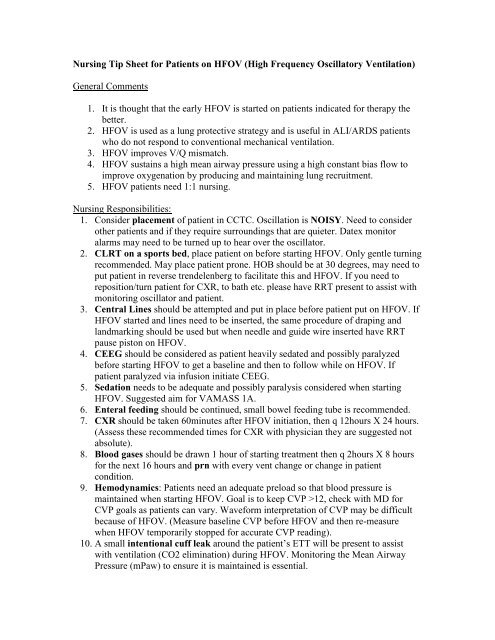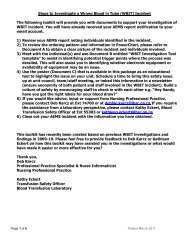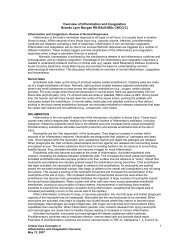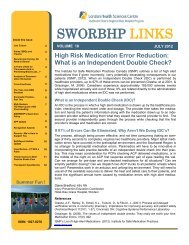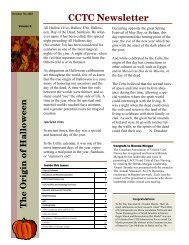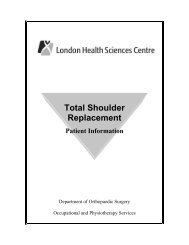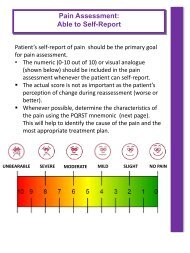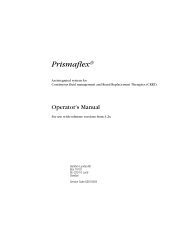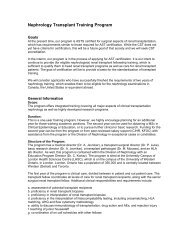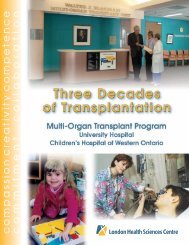Nursing Tip Sheet for Patients on HFOV (High Frequency Oscillatory ...
Nursing Tip Sheet for Patients on HFOV (High Frequency Oscillatory ...
Nursing Tip Sheet for Patients on HFOV (High Frequency Oscillatory ...
Create successful ePaper yourself
Turn your PDF publications into a flip-book with our unique Google optimized e-Paper software.
<str<strong>on</strong>g>Nursing</str<strong>on</strong>g> <str<strong>on</strong>g>Tip</str<strong>on</strong>g> <str<strong>on</strong>g>Sheet</str<strong>on</strong>g> <str<strong>on</strong>g>for</str<strong>on</strong>g> <str<strong>on</strong>g>Patients</str<strong>on</strong>g> <strong>on</strong> <strong>HFOV</strong> (<strong>High</strong> <strong>Frequency</strong> <strong>Oscillatory</strong> Ventilati<strong>on</strong>)<br />
General Comments<br />
1. It is thought that the early <strong>HFOV</strong> is started <strong>on</strong> patients indicated <str<strong>on</strong>g>for</str<strong>on</strong>g> therapy the<br />
better.<br />
2. <strong>HFOV</strong> is used as a lung protective strategy and is useful in ALI/ARDS patients<br />
who do not resp<strong>on</strong>d to c<strong>on</strong>venti<strong>on</strong>al mechanical ventilati<strong>on</strong>.<br />
3. <strong>HFOV</strong> improves V/Q mismatch.<br />
4. <strong>HFOV</strong> sustains a high mean airway pressure using a high c<strong>on</strong>stant bias flow to<br />
improve oxygenati<strong>on</strong> by producing and maintaining lung recruitment.<br />
5. <strong>HFOV</strong> patients need 1:1 nursing.<br />
<str<strong>on</strong>g>Nursing</str<strong>on</strong>g> Resp<strong>on</strong>sibilities:<br />
1. C<strong>on</strong>sider placement of patient in CCTC. Oscillati<strong>on</strong> is NOISY. Need to c<strong>on</strong>sider<br />
other patients and if they require surroundings that are quieter. Datex m<strong>on</strong>itor<br />
alarms may need to be turned up to hear over the oscillator.<br />
2. CLRT <strong>on</strong> a sports bed, place patient <strong>on</strong> be<str<strong>on</strong>g>for</str<strong>on</strong>g>e starting <strong>HFOV</strong>. Only gentle turning<br />
recommended. May place patient pr<strong>on</strong>e. HOB should be at 30 degrees, may need to<br />
put patient in reverse trendelenberg to facilitate this and <strong>HFOV</strong>. If you need to<br />
repositi<strong>on</strong>/turn patient <str<strong>on</strong>g>for</str<strong>on</strong>g> CXR, to bath etc. please have RRT present to assist with<br />
m<strong>on</strong>itoring oscillator and patient.<br />
3. Central Lines should be attempted and put in place be<str<strong>on</strong>g>for</str<strong>on</strong>g>e patient put <strong>on</strong> <strong>HFOV</strong>. If<br />
<strong>HFOV</strong> started and lines need to be inserted, the same procedure of draping and<br />
landmarking should be used but when needle and guide wire inserted have RRT<br />
pause pist<strong>on</strong> <strong>on</strong> <strong>HFOV</strong>.<br />
4. CEEG should be c<strong>on</strong>sidered as patient heavily sedated and possibly paralyzed<br />
be<str<strong>on</strong>g>for</str<strong>on</strong>g>e starting <strong>HFOV</strong> to get a baseline and then to follow while <strong>on</strong> <strong>HFOV</strong>. If<br />
patient paralyzed via infusi<strong>on</strong> initiate CEEG.<br />
5. Sedati<strong>on</strong> needs to be adequate and possibly paralysis c<strong>on</strong>sidered when starting<br />
<strong>HFOV</strong>. Suggested aim <str<strong>on</strong>g>for</str<strong>on</strong>g> VAMASS 1A.<br />
6. Enteral feeding should be c<strong>on</strong>tinued, small bowel feeding tube is recommended.<br />
7. CXR should be taken 60minutes after <strong>HFOV</strong> initiati<strong>on</strong>, then q 12hours X 24 hours.<br />
(Assess these recommended times <str<strong>on</strong>g>for</str<strong>on</strong>g> CXR with physician they are suggested not<br />
absolute).<br />
8. Blood gases should be drawn 1 hour of starting treatment then q 2hours X 8 hours<br />
<str<strong>on</strong>g>for</str<strong>on</strong>g> the next 16 hours and prn with every vent change or change in patient<br />
c<strong>on</strong>diti<strong>on</strong>.<br />
9. Hemodynamics: <str<strong>on</strong>g>Patients</str<strong>on</strong>g> need an adequate preload so that blood pressure is<br />
maintained when starting <strong>HFOV</strong>. Goal is to keep CVP >12, check with MD <str<strong>on</strong>g>for</str<strong>on</strong>g><br />
CVP goals as patients can vary. Wave<str<strong>on</strong>g>for</str<strong>on</strong>g>m interpretati<strong>on</strong> of CVP may be difficult<br />
because of <strong>HFOV</strong>. (Measure baseline CVP be<str<strong>on</strong>g>for</str<strong>on</strong>g>e <strong>HFOV</strong> and then re-measure<br />
when <strong>HFOV</strong> temporarily stopped <str<strong>on</strong>g>for</str<strong>on</strong>g> accurate CVP reading).<br />
10. A small intenti<strong>on</strong>al cuff leak around the patient’s ETT will be present to assist<br />
with ventilati<strong>on</strong> (CO2 eliminati<strong>on</strong>) during <strong>HFOV</strong>. M<strong>on</strong>itoring the Mean Airway<br />
Pressure (mPaw) to ensure it is maintained is essential.
11. Chest wiggle is present <strong>on</strong> <strong>HFOV</strong> from clavicular to mid- thigh bilaterally. If a<br />
change in chest wiggle occurs a RRT needs to be notified immediately. Unilateral<br />
wiggle-may indicate right main-stem intubati<strong>on</strong> or pneumothorax.<br />
Decrease Bilateral wiggle-may indicate change in lung compliance, lung/airway<br />
resistance or need <str<strong>on</strong>g>for</str<strong>on</strong>g> sucti<strong>on</strong>ing.<br />
12. Documentati<strong>on</strong>; hourly chest wiggle and sound, hourly Mean airway pressure<br />
(mPaw), hourly amplitude and Hertz (frequency) hourly- nurses will chart this from<br />
the oscillator. Chest wiggle and sound will be documented <strong>on</strong> the A & I with<br />
descripti<strong>on</strong> as well as <strong>on</strong> the flowsheet. The descripti<strong>on</strong> of chest wiggle and sound<br />
can be difficult so <strong>on</strong> shift change, per<str<strong>on</strong>g>for</str<strong>on</strong>g>m an assessment of chest wiggle and<br />
sound with <strong>on</strong>coming shift or any<strong>on</strong>e covering patient. Some traditi<strong>on</strong>al audible<br />
alarms may not be available <strong>on</strong> the <strong>HFOV</strong> <strong>on</strong>ly visual by flashing lights. Notify<br />
RRT immediately if alarm activated.<br />
13. Head movement or repositi<strong>on</strong>ing may cause a <strong>HFOV</strong> to alarm and stop. Be very<br />
careful when repositi<strong>on</strong>ing the patient’s head.<br />
14. The circuit of the <strong>HFOV</strong> must always remain straight, not kinked or twisted<br />
because it will increase impedance.<br />
15. Heart, lung and bowel sounds will not be able to be heard over the noise of the<br />
<strong>HFOV</strong>. Try to collaborate with the RRT and MD to listen at the same time by<br />
having the RRT turn off the pist<strong>on</strong> of the <strong>HFOV</strong>. Stopping the pist<strong>on</strong> stops the<br />
c<strong>on</strong>stant mean airway pressure from being maintained.<br />
16. Sucti<strong>on</strong>ing requires the assistance of the RRT as the pist<strong>on</strong> <strong>on</strong> the <strong>HFOV</strong> must be<br />
stopped and the RRT may need to per<str<strong>on</strong>g>for</str<strong>on</strong>g>m a lung recruitment strategy post<br />
sucti<strong>on</strong>ing. Sucti<strong>on</strong>ing should be avoided the first 12-24 hours to encourage lung<br />
recruitment.<br />
17. PPE- Use additi<strong>on</strong>al precauti<strong>on</strong>s-Please wear a face mask with shield when in the<br />
room with a patient <strong>on</strong> <strong>HFOV</strong>. (within 1 meter of patient).<br />
Prepared by;<br />
Gina Souliere RN BScN<br />
September 2009.<br />
Reviewed; March 29, 2010.<br />
References:<br />
1. VIASYS Healthcare. Initial Clinical Guidelines <str<strong>on</strong>g>for</str<strong>on</strong>g> <strong>HFOV</strong> 3100B in Adults: March<br />
2002<br />
2. Derdak S, Mehta S, Stewart T, Smith T, Rogers M, Buchman T, Carlin B, Lows<strong>on</strong><br />
S, Grant<strong>on</strong> J. <strong>High</strong>-<strong>Frequency</strong> <strong>Oscillatory</strong> Ventilati<strong>on</strong> <str<strong>on</strong>g>for</str<strong>on</strong>g> Acute Respiratory<br />
Distress Syndrome in Adults; A Randomized, C<strong>on</strong>trolled Trial. Am J Respir Crit<br />
Care Med 2002; 166: 801:808<br />
3. Mehta S, Lapinsky S, Hallet D, Merker D, Groll R, Cooper A, MacD<strong>on</strong>ald R,<br />
Stewart T. Prospective Trial of <strong>High</strong>-<strong>Frequency</strong> Oscillati<strong>on</strong> in Adults with Acute<br />
Respiratory Distress Syndrome. Crit Care Med 2001; 29; 7; 1360-1369
4. Fort P, Farmer C, Westerman J, Johannigman J, Beninati W, Dolan S, Derdak S,<br />
<strong>High</strong> <strong>Frequency</strong> <strong>Oscillatory</strong> Ventilati<strong>on</strong> <str<strong>on</strong>g>for</str<strong>on</strong>g> Adult Respiratory Distress Syndrome -<br />
A Pilot Study. Crit Care Med 1997; 25; 6; 937-947Oscillate Pilot Protocol Versi<strong>on</strong><br />
Date May 24, 2007<br />
5. Henry E. Fessler, MD; Stephen Derdak, DO; Niall D. Fergus<strong>on</strong>, MD, FRCPC,<br />
MSc; David N. Hager, MD; Robert M. Kacmarek, PhD; Taylor Thomps<strong>on</strong>, MD;<br />
Roy G. Brower, MD. A protocol <str<strong>on</strong>g>for</str<strong>on</strong>g> high-frequency oscillatory ventilati<strong>on</strong> in<br />
adults: Results from a roundtable discussi<strong>on</strong> Crit Care Med 2007; V35;7


